


-
Details
- Date
- 2019
- Media category
- Painting
- Materials used
- oil, oil crayon, wax pencil and pencil on linen
- Dimensions
- 193.0 x 152.4 cm
- Signature & date
Signed and dated u.l. verso, black crayon/pencil "Kamrooz Aram/ 2019".
- Credit
- Roger Pietri Fund and the Asian Art Collection Benefactors 2019
- Location
- South Building, lower level 1, 20th-century galleries
- Accession number
- 135.2019
- Copyright
- © Kamrooz Aram
- Artist information
-
Kamrooz Aram
Works in the collection
- Share
-
-
About
This painting was first exhibited as part of the artist’s solo exhibition, 'Arabesque' at the Green Art Gallery, Dubai in March - May 2019. A grid underlies the painting and offers a formal and cultural structure on top of which Aram intuitively composes a series of curved forms that reference the processes of American minimalism ,the curves of Farsi script, the ornamentation of Persian architecture and the natural motions of the artist’s arm and hand. Viewed through a Western lens, the figure of Matisse looms large and the artist has commented that he was thinking and reading about Matisse’s interest in Islamic art while producing the paintings in 'Arabesque'. Indeed, there is a sense in which Aram’s exhibition sought to explore his own relationship to the notion of ‘arabesque’ via an interrogation of Matisse’s orientalist gaze. As Aram wrote in his artist statement:
Arabesque is a term that has a range of associations. The most general definition refers to the leafy and floral forms that undulate throughout a surface such as a carpet or a tiled wall, conflating figure and ground, and moving our eyes along the surface in a continuous dance. But perhaps an even more common reference for the term is that of the ballet position, which one can assume takes its name from the ornamental form.The term, of course, was coined by Europeans—likely the French, who discovered such forms in North African art and architecture. But there is evidence that the French term is derived from the Italian, Arabesco. Arabesque: the suffix -esque, meaning in the style of, resembling; in other words Arab-like. Arabesque is part of an exoticist lexicon that now belongs to the exoticised. As a young immigrant in the United States, so many Americans thought I was Arab that I became Arab. It occurs to me that I am Arabesque. It occurs to me that there is no such thing as the Arabesque. (Kamrooz Aram, 'In memory of the Arabesque', February 2019).
-
Exhibition history
Shown in 4 exhibitions
Arabesque, Green Art Gallery, Dubai, 18 Mar 2019–30 May 2019
Some mysterious process, Art Gallery of New South Wales, Sydney, 01 Jun 2020–13 Sep 2020
Matisse Alive, Art Gallery of New South Wales, Sydney, 11 Oct 2021–03 Apr 2022
20th-Century galleries, lower level 1 (rehang), Art Gallery of New South Wales, Sydney, 20 Aug 2022–2023
